In today’s post, I want to talk about how to measure your performance as an author. Now, I get that this may be a touchy subject because if you feel you’re not doing well or that you should be doing better, looking at the evidence may discourage you. But I’ve always been a firm believer in that you need to measure things, because if you don’t set goals, you’ll never know if you reached them. So today, let’s look at the rankings and numbers you should track. Because I’m exclusive to Amazon, I can only discuss those.
Sales Stats
The first set of numbers is pretty obvious: your sales and KU stats. In case you’re new to publishing: if you self-publish through Amazon, you can find these in your KDP dashboard. The top graphic will show you the sales of all your books combined and the bottom graph are you page reads in Kindle Unlimited and borrowed books through the lending program. Here’s a screenshot of mine (I’ve blacked out the scale numbers on the left).
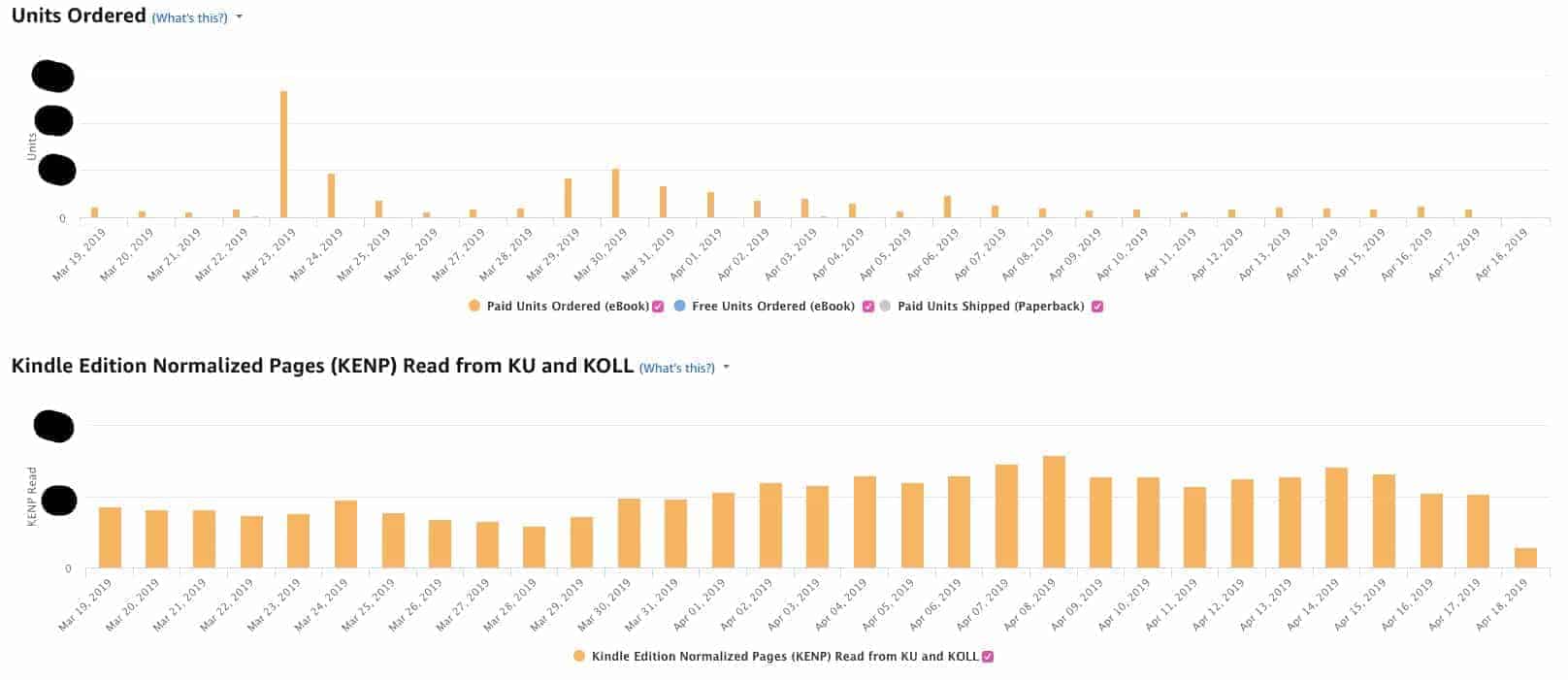
This is a quick snapshot you should look at at least once a week to see how you’re doing. And if you’re running ads or doing any kind of extra promo, look at this daily to see what works. That huge jump you see on March 23rd for example, that’s when The Time of My Life went on a 99c sale. As you can see, that had quite the effect.
Obviously, you can search for specific books or dates to get the exact information you need.
Bookreport
There’s a program called Bookreport that many authors use that shows this same information, but in a much more intuitive way. It uses colorful pie charts to show you how much each book sold and contributed to that day’s sales, for example, and it presents the numbers in a more accessible way.
It also quantifies sales and KU reads into money earned right away, so you can make a pretty good estimate of what you earn on any given day. That’s a sweet thing to look at, except Bookreport is only free if you earn less than a thousand bucks a month. Above that, you pay about $20 a month.
I can’t show you a screenshot anymore because I just canceled my subscription after having it for a year. While I love the overview it gives me, I think it’s a lot of money to spend on getting the same info as you can get in KDP. The only extra thing is the translation into an earned amount, and I created an Excel sheet that does the exact same thing when I feed it my numbers.
KDP Dashboard Beta Version
The KDP dashboard also has a beta version that offers a more visual view. Just go to your old KDP dashboard and at the top of the page it will say “Try the new KDP reports beta”. The graph in the beta version for that same period looks like this:

Each color represents a book, and clearly, orange is The Time of My Life, haha. It’s easy to see which book is doing well, and if you hover over a certain day, it will show you the exact sales numbers per book.
There’s a separate graph for the KU reads, see below. You can see exactly when I released the No Shame box set, which is the bright blue. What’s cool about the beta version is that it also shows you the sales and KU reads per Amazon store, which is really helpful to determine where you’re most successful (and where you may want to run some ads, for example)
Sales Ranking
Another set of numbers to look at is your sales ranking per book. Every book has a sales ranking, both in the categories it’s listed in as well as in the whole Kindle store (assuming it’s an ebook). This ranking is visible for everyone on the book’s Amazon page. Let me show an example:
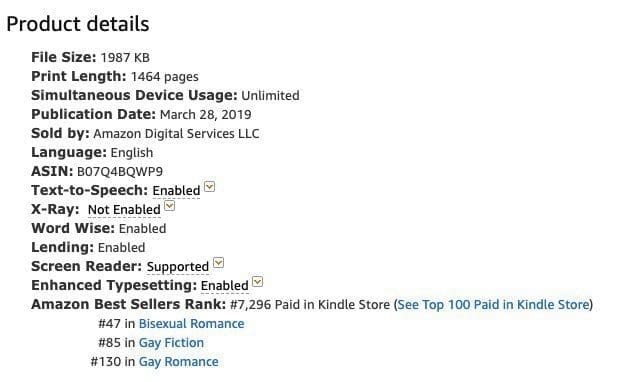
These are the details for my latest release, the No Shame box set. It tells you when it was released, the number of pages, the publisher (self published), etc. And at the bottom, it shows the bestseller rank in three categories and in the whole Kindle store.
Category Ranking
Let’s talk about the categories first. When you upload your book, you can choose two categories yourself and you enter keywords that will determine (together with the content of your book, so Amazon says), what categories you’ll end up in. So far, I’ve been lucky and I’ve always ended up in the right categories.
In each category, you have a ranking. Now, technically speaking, the ranking in a category doesn’t mean all that much in itself. As you can see, I rank much higher in Bisexual Romance than I do in Gay Romance, but that’s because the first is a much smaller category. In smaller categories, it’s easier to rank high or even get that coveted number one spot and the accompanying orange/yellow banner. In that sense, it can me misleading because it may look like a book is doing really well, but that’s just because there’s not much competition in that category. The competition in Gay Romance is fierce, so a high ranking there actually means something. That’s the holy grail, so to speak.
Category rankings do matter in one sense: they mean Amazon will start promoting your book organically. That’s super useful, of course…but only if it’s listed in the right category. Deliberate miscategorizing in a smaller category just to get an orange banner is not only unfair toward the authors who legitimately belong in that category, but it can also backfire spectacularly when Amazon starts recommending your book to the wrong people. If your book is ranked high in transgender romance, for example, but doesn’t have a transgender character and Amazon recommends it to people who look for transgender romance, do you think they’ll appreciate being mislead? You could end up with negative reviews at the least but a completely messed up recommendation algorithm for your book at worst, which means Amazon will stop showing it.
Overall Sales Ranking
The best way to tell how a book is doing is not to look at the categories, but at the overall sales rank in the Kindle store. That tells you how a book is really doing. In this case, my box set is sitting at the #7,269 spot, which is not bad, but definitely not super high (which makes sense ’cause the book has been out a few weeks now). If you want to know how your book is doing compared to similar books or authors, compare the overall sales ranking.
Let me expand on this a little bit, because if you start paying attention to the overall sales ranking, you’ll also come to understand how relative the category rankings are. To show you that, let’s look at the current top eight in gay romance.
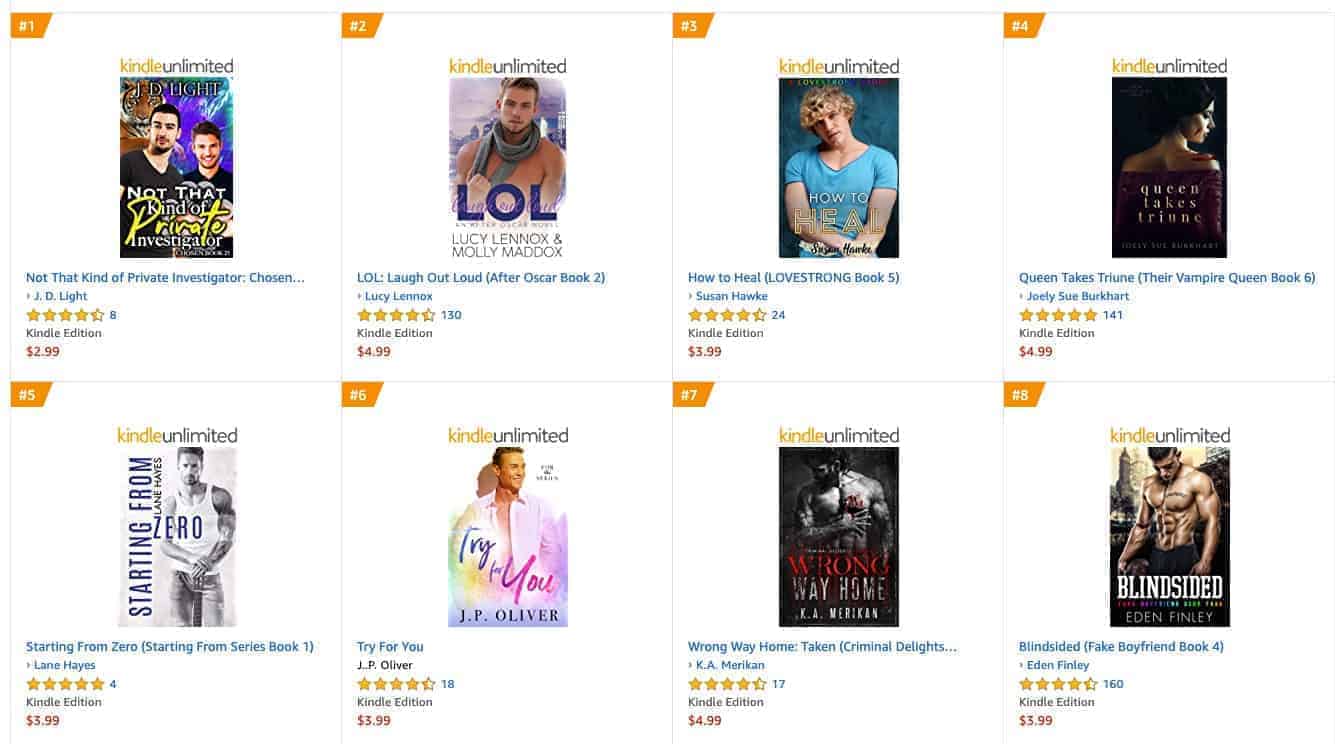
These are the most popular books in the gay romance category right now (Amazon determines the ranking base don sales and KU downloads, not page reads). But whether or not a book will rank high in this category is also determined by how competitive the top books are. By that I mean that you need to look at how close they are in rank together and how high the top three ranks in overall rank.
The #1 book, JD Light’s book, has this ranking:

The book is #324 in the entire Kindle store. If you never pay attention to this, that may seem pretty high, but actually, it’s relatively low for the number one spot in gay romance. You’ll see for instance when Lucy Lennox has just released a book or Sloane Kennedy and they’re in number one on their first or second day, that their overall ranking is much, much lower. Lucy usually hits below the #100 spot. That shows you once again that category rankings are super relative to how busy and competitive that category is at that specific time. If some big name authors all release close together, you’ll see the top rankings rise to under that #100 spot.
If you look at the other rankings of the top eight books, you can see whether or not they’re close together. Here’s the #2, Lucy Lennox and Molly Maddox:

See how close it is in ranking to the #1 book? You can expect those to swop places sometime during the day. And to round off our top three, let’s look at the #3 book, which is Susan Hawke’s:

There’s a gap of almost 200 books between the #1 and #3 spot. That’s still not super big, because at that level a few sales will make you jump tens of places up. And here’s the ranking for the #8 spot, Eden Finley’s book:

First of all, note that the gay romance category isn’t even listed for her book. Amazon usually puts your book in more than three categories but it only shows three. You’re still ranking in the other categories. In Eden’s case, it shows the three categories she’s ranking highest in. But you can see that she’s in #961 overall. That means the competition in the top eight is close right now. If it’s that close, you’ll see a lot of book swop places throughout the day, as a single sale more can make you jump up a spot.
You may wonder why this is relevant. Well, first of all it shows that high category rankings are relative, since they depend on the competition at that specific point within that category. You wanna see how successful a book really is? Look at the overall ranking.
Second, if you know this and start to recognize it, you can try to release a book at the right time, meaning when the top eight books in your category aren’t ranked super high overall. That way, you’ll have a better shot at a higher spot and thus at getting Amazon to work in your favor and recommend your book organically. This only works if you have a book sitting and ready to launch at that time, of course, but it’s a fun thing to try sometime.
Author Rank
The third and last bit of numbers you should look at is your author rank. This is only visible to you, not to readers or others, and can be accessed through your Amazon Author Central dashboard. If you look under the tab Sales Info, you can find a sales rank per book, which is super cool to see, but also an author rank.
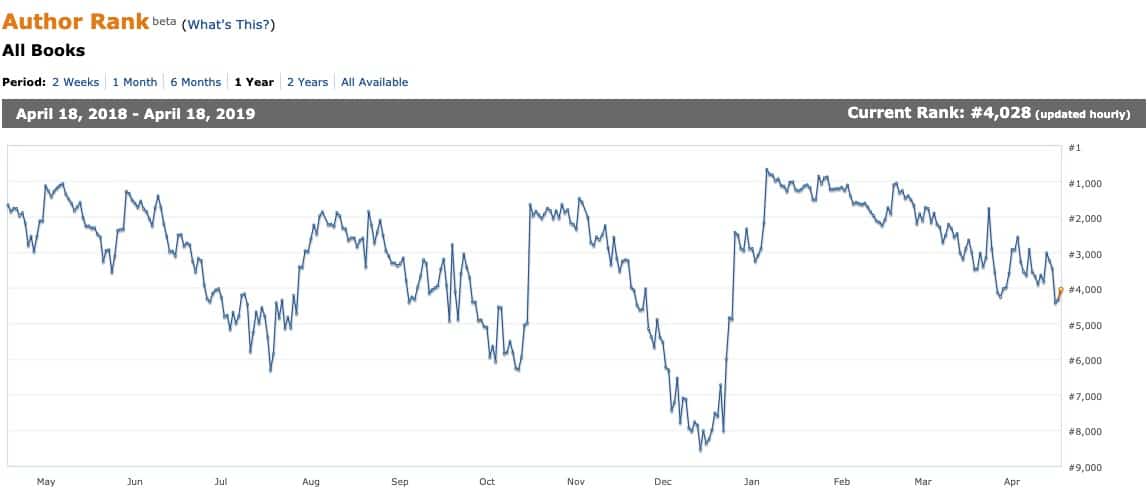
This is my author rank and as you can see, I’m ranked #4028 right now, which means there are 4,027 authors who do better than me, haha. What’s interesting about this graph, however, is that it tells you how you’re doing over time and if you’re holding your position or if you’re dropping or growing.
It also shows quite clearly the effect of new releases, because every insane jump you see here is the release day of a new book. As you can see, I dropped significantly lower in December. No wonder, since I hadn’t released since October (the jump you see there is from Alpha’s Pride and Ignite). As soon as I released again (No Angel came out December 27, followed by Campy and Kissing the Teacher), my rank climbed right back up. If nothing else, this graph shows the immediate effect of new releases on your author rank.
Wow, this must be the longest post I’ve written so far, haha. I hope this was useful. Obviously, there’s a lot more you can track, but these are the most important numbers. They don’t include the stuff you need to keep an eye on when you run any kinds of ads, but that’s a whole other story…

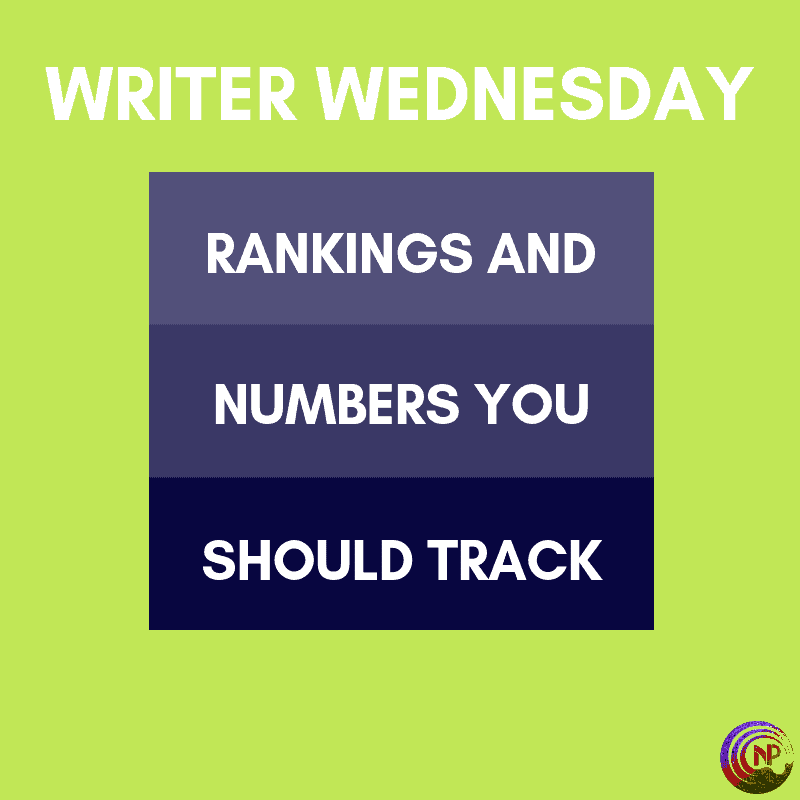
I love these blog posts that explain about the behind the scenes of being an author. It really does highlight how much other ‘stuff’ authors need to keep on top of, it’s not just a case of releasing a book. I guess writing the book seems to be the easy part.
I wouldn’t say the actual writing is the easy part, haha, but yeah, being an author requires a lot more than that. We have a lot of things on our plate every day aside from just writing.
Hello my lovely, my issue is you talk about key words but I’m not sure what key words I should be picking? And is that important to all the above, because it seems it is, when it comes to categories.
Again this is something that confuses me but relates to all you have discussed.
I’m okay at looking at the data and the points you make are translated easily when you look deeper at the numbers.
Key words are super duper important, because they determine your category. Think of key words as the search terms readers will search for on Amazon to find your book…or that you want your book to show up for. The key words you have to choose depend on your subgenre, but if you want to make sure you end up in gay romance, make sure to list that in a few. Keep in mind that you can combine key words into one long one, which gives you even more options. Instead of doing “gay romance” and “MM romance” for example, you could do “gay MM romance” or even “gay mm lgbt romance with suspense”. Amazon will accept that as one key word. You can also pick tropes, eg “first time gay romance” or “firefighter cops alpha men gay romance” (just making this one up, haha). Or list certain elements, like “BDSM romance” or “gay romance with daddy kink” (be careful with hose terms though, as they may land you in the erotica categories rather than romance) Whatever you choose, just be honest that they actually fit your book.